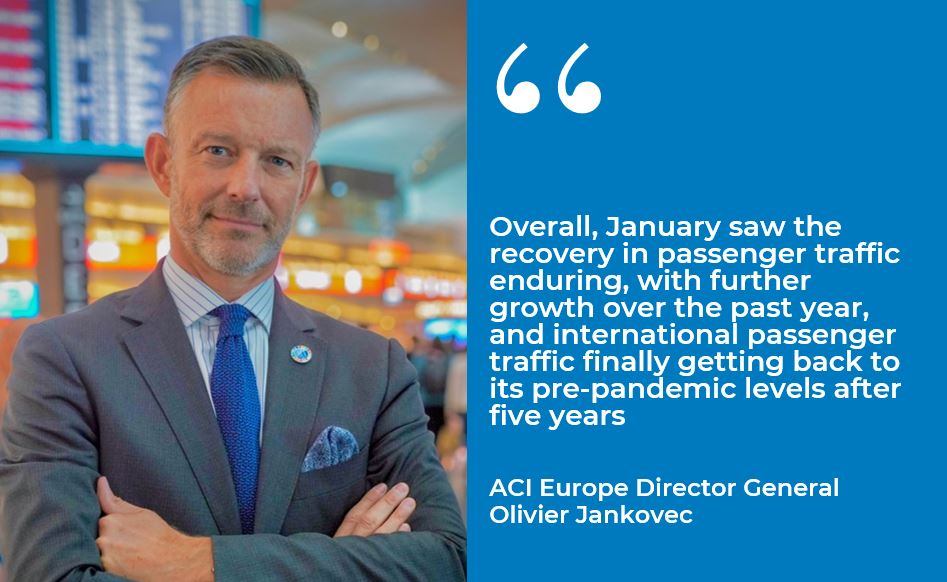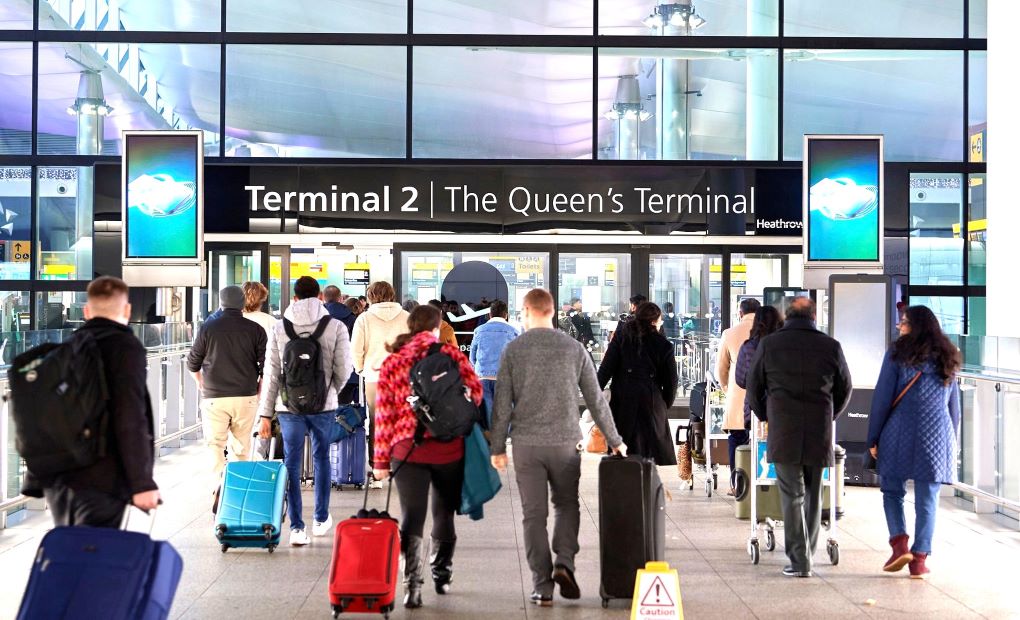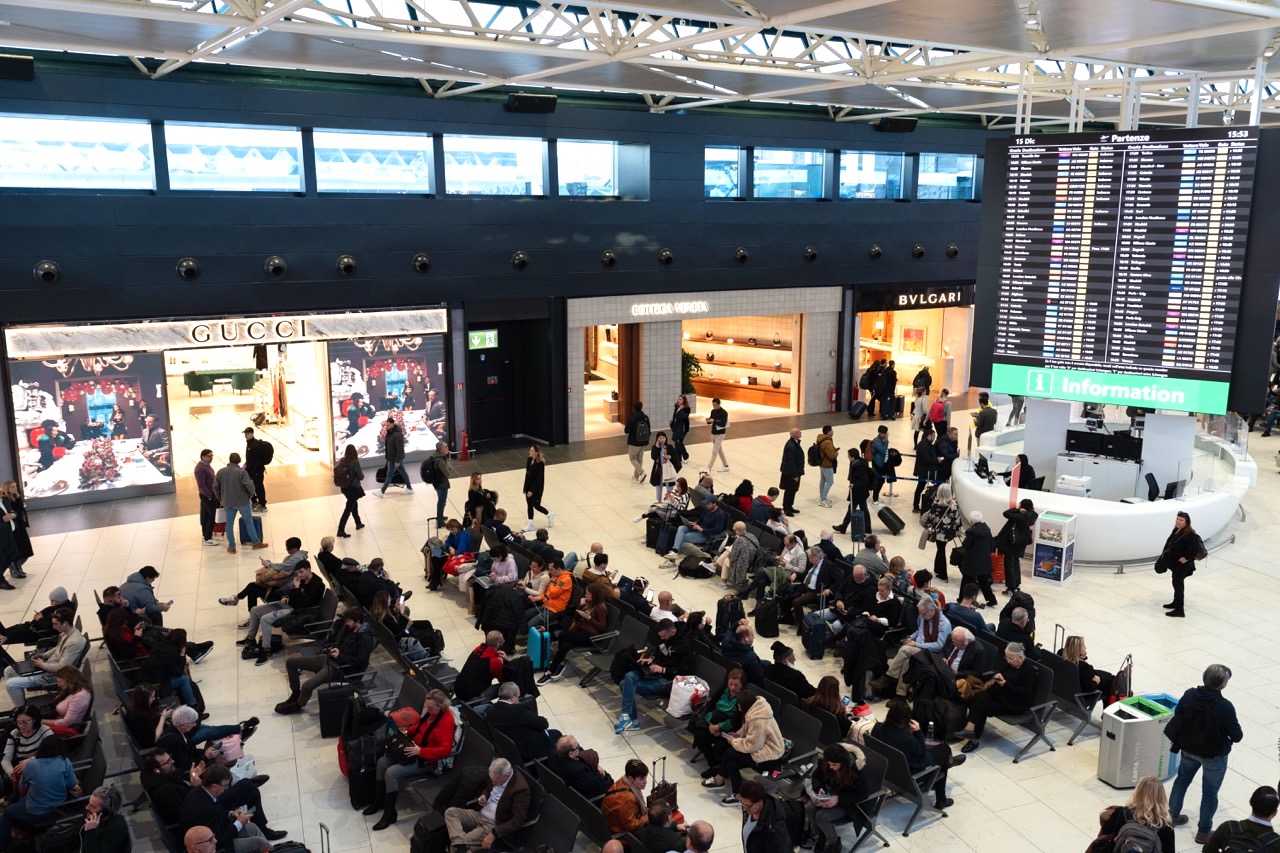EUROPE. Passenger traffic figures from Airports Council International (ACI) Europe show international passenger volumes at European airports reached full recovery in January for the first time since the pandemic.
International passenger traffic for the month grew by +8% year-on-year, while the number of domestic passengers rose by just +2%.
While domestic traffic is still -13% below January 2019 levels, international passenger traffic helped boost overall passenger numbers across Europe by +7% year-on-year compared to January 2023.
Thanks to the improvement in international travel demand, total passenger traffic came close to pre-pandemic levels, reaching 97% of the figures recorded in 2019.

ACI Europe Director General Olivier Jankovec said: “Overall, January saw the recovery in passenger traffic enduring, with further growth over the past year, and international passenger traffic finally getting back to its pre-pandemic levels after five years.
“Demand generally remained resilient in the face of much-increased airfares, even though the growth dynamic slowed down or even stalled in a few markets.
“This is adding further divergences to an already much-fragmented airport market, where geopolitics and structural aviation market changes – including the primacy of leisure demand and selective low-cost carrier expansion – are shaping traffic performance like never before.”
He added: “Looking at the months ahead, macro-economic conditions are set to improve in the EU and the UK in particular, with further drops in inflation and growth in real wages. Combined with consumers prioritising experiences and leisure, this should support continued growth in demand for air travel – with headwinds still coming mainly from supply pressures and higher airfares as well as geopolitics.”
Performance variations across national markets
The EU+ market led the passenger growth dynamic in January, up by +8% over the same period in 2023.
The best-performing airports were Slovenia (+29.8%), Czech Republic (+28.9%), Malta (+22.6%), Poland (+18.9%) and Hungary (+16.6%).
Negative traffic figures were registered in other airports including Sweden (-1.3%) and the Netherlands (-0.8%), while airports in Romania and Latvia posted a slow growth (both at +1.3%) alongside France, Portugal and Norway (all at +1.7%).
When compared to January 2019 levels, the EU+ market stood at -4%. Airports traditionally relying on leisure and VFR traffic surpassed their pre-pandemic records. These include Malta (+27%), Cyprus (+21.6%), Poland (+20.5%), Croatia (+15.9%), Portugal (+14.8%), Spain (+12.7%) and Greece (+12.4%).
By contrast, airports in Slovakia (-38.8%), Sweden (-29.2%), Slovenia (-27.5%), Finland (-24.2%) and Germany (-23.7%) are still well behind a full recovery.
ACI also noted a steep decline in domestic passenger traffic at airports in Germany (‑50.9%), Sweden (-41.6%) and Finland (-31.5%) – which contributed to their overall underperformance – as well as at those in France (-30.5%) and the UK (‑21.6%).
Conversely, airports in Spain (+12.9%), Portugal (+7.3%), Greece (+6.9%) and Italy (+1.3%) saw domestic passenger numbers surpass pre-pandemic levels.
Across the rest of the region, airports in smaller markets recorded higher passenger volumes in January, up by +3% compared to the same month in 2023. Notable increases came from those in Albania (+51.2%), North Macedonia (+47.1%), Uzbekistan (+46.1%), Georgia (37.4%), and Bosnia and Herzegovina (+26.8%).

Airports in the major market of Türkiye (+3.8%) maintained their growth dynamic despite a slump in the number of domestic passengers (-19%).
Ukrainian airports remained closed due to the Russia-Ukraine war; and the conflict in Israel impacted its airports heavily (-56.3%).
When compared to January 2019 volumes, airports in the rest of Europe outperformed the continent’s average at +2%. Airports in Uzbekistan (+210%) have tripled their passenger volumes, followed by those in Albania (+182%), Kazakhstan (+103%), Armenia (+80%), Kosovo (+70.2%) and Serbia (+60.2%).
Performance variations across airport categories
January passenger traffic across other major airports in Europe surged by +8.3% year-on-year. The improvement was led by the strong transatlantic demand, the progressive return of Chinese travellers, and network airlines increasing capacity, ACI noted.
The development resulted in the ‘Majors’ or the top five largest airports achieving almost a full recovery at -1.4% compared to January 2019.
London Heathrow continued to be the busiest airport in the region, posting a +9.4% year-on-year increase in passenger traffic, and +1.3% higher than January 2019 figures.

This was followed by Istanbul, which served just 8,000 passengers less than the British hub. Passenger traffic at Istanbul Airport rose by +6.4%, compared to the same month in 2023, exceeding its January 2019 record by +15%. Paris Charles de Gaulle Airport remained in third position, registering a +2.2% year-on-year increase, and -10.2% behind January 2019 levels.
Madrid (+8.1% vs January 2023 and +9.2% vs January 2019) took the fourth spot from Amsterdam (-0.9% vs January 2023 and -9.2% vs January 2019).
Rome Fiumicino also delivered a strong growth (+27.9% vs January 2023 and +5.2% vs January 2019), largely driven by the performance of the Majors.
Among the Mega and Large airports, the most notable increases were seen in Prague (+28.5% vs January 2023 and -13.1% vs January 2019), Warsaw (+21.5% vs January 2023 and +15.5% vs January 2019), Alicante (+20.6% vs January 2023 and +22.1% vs January 2019 ) and Malaga (+20.1% vs January 2023 and +32.5% vs January 2019).
ACI highlighted the best passenger traffic performance among medium-sized airports, with an average year-on-year increase of +9.6% in January.

This was the only segment to surpass its pre-pandemic January 2019 volumes by +5%.
ACI noted that the top-performing airports were mostly from the non-EU+ market. These are: Bourgas (+105.5% vs January 2023 and + 7.7% vs January 2019); Kutaisi (+77.7% vs January 2023 and + 171.8% vs January 2019); Tirana (+51.2% vs January 2023 and +181.5% vs January 2019); Skopje (+50.5% vs January 2023 and + 50.9% vs January 2019); Samarkand (+46.1% vs January 2023 and +210.1% vs January 2019); and Florence (+32.5% vs January 2023 and +13.1% vs January 2019).
In keeping with previous passenger results, ACI Europe observed that performance from larger low-cost bases continued to exceed their January 2019 levels, including Memmingen (+72.3%), Beauvais (+41.3%), Bergamo (+29.5%) and Charleroi (+21.6%).
In contrast, passenger traffic in small airports slid year-on-year by -0.7% in January, remaining -31% below January 2019 levels.
Data by airport groups
Throughout January, airports serving more than 40 million passengers per year (Majors), airports with 25 to 40 million passengers (Mega), airports welcoming between 25 and 10 million passengers (Large), airports serving between 1 million and 10 million passengers per year (Medium), and airports welcoming between 1,000 and 1 million passengers (Small) posted an average change in passenger traffic of -1.4%, -1.8%, -9.2%, +5% and -31% respectively, compared to January 2019.
The airports that reported the highest increases in passenger traffic (vs January 2019) are as follows:
Major: Istanbul +15.0%, Madrid +9.2%, Barcelona +7.1%, Rome +5.2%, London +1.3%.
Mega: Athens +15.0%, Istanbul +14.3%, Lisbon +14.2%, Antalya +9.7%, Palma de Mallorca +6%.
Large: Sochi +95%, Málaga +32.5%, Milan Bergamo +29.5%, Catania +24.5%, Alicante +22.1%.
Medium: Samarkand +210.1%, Tirana +181.5%, Kutaisi +171.8%, Almaty +109.2%, Astana +95.0%.
Small: Kramfors +144.4%, Babimost +139.7%, Porto Santo +88.8%, Sitia +87.5%, Batumi +82.7%. ✈











